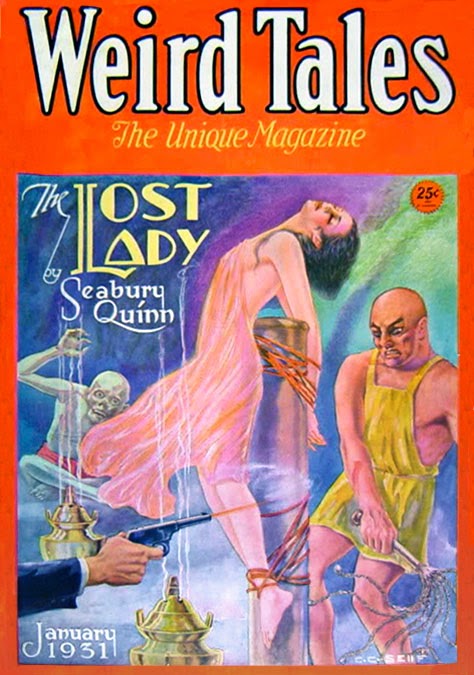Pseudonym of Marietta Holley
Aka "Josiah Allen's Wife"
Poet, Author, Humorist, Music Teacher
Born July 16, 1836, near Adams, Jefferson County, New York
Died March 1, 1926, near Pierrepont Manor, Jefferson County, New York
I have pored through the list of writers who contributed to Weird Tales, and I thought I had found all of its writers of the nineteenth century. Now another turns up. I guess this is why it's called research.
The November 1927 issue of Weird Tales closed with a long poem called "The Haunted Mansion" by Marietta Hawley. That name would not have been familiar to readers, for it was an old pseudonym of an author who had passed away the year before at age eighty-nine. Her poem would not have been familiar, either, for it was already six decades old, having originally appeared in 1867 in Peterson's Magazine as "The Haunted Castle." The author's real name, Marietta Holley, would likely have been unknown as well. And perhaps only a few readers would have remembered her nom de plume, "Josiah Allen's Wife." Nonetheless, at one time, Marietta Holley was one of the most popular writers in America.
Marietta Holley was born on July 16, 1836, near the town of Adams in Jefferson County, New York. Called "the female Mark Twain," she was younger than old Sam Clemens by just eight months. Like him and other American humorists of the nineteenth century ("Josh Billings,""Petroleum V. Nasby"), Marietta Holley used a pseudonym in her popular writings. She began as "Marietta Hawley," a poet, but with the publication of My Opinions and Betsey Bobbet's (1872), she became known as "Josiah Allen's Wife." Over the next four decades, Marietta Holley wrote more than two dozen books. Ten were in her very popular "Samantha" series, Samantha being Mrs. Josiah Allen and the narrator of the books.
The New York Times called the Samantha series "beloved" by readers of the 1880s through the early 1900s, yet Marietta was little remembered even late in her own lifetime. My library is small, but I have not found her in The Popular Book by James D. Hart (1950) or The Popular American Novel, 1865-1920 by Herbert F. Smith (1980). Nor have I found her in American Humor by Constance Rourke (1931), The Rise and Fall of American Humor by Jesse Bier (1968), or The Comic Spirit in America edited by John K. Massey (1969). Then I looked in the book Laughing Their Way: Women's Humor in America by Martha Bensley Bruère and Mary Ritter Beard (1934), and there she is--though only briefly (and, incidentally, in a section called "Feminists"). The point of all this is that the writings of Marietta Holley, so popular in their day, quickly passed from memory after her death. Kate H. Winter has helped to revive the memory of "Josiah Allen's Wife" in Marietta Holley: Life with "Josiah Allen's Wife", originally published in 1984 and more recently in a paperback edition.
Marietta Holley died on March 1, 1926, thus she lived into the Weird Tales era, though not long enough to see her poem published in the November 1927 issue. That poem, again, originally entitled "The Haunted Castle," was reprinted in Weird Tales as "The Haunted Mansion." I can't say why. In any case, here it is in its entirety.
The Haunted Castle
by Marietta Holley(reprinted in Weird Tales as "The Haunted Mansion")
It stands alone on a haunted shore,With curious words of deathless lore
On its massive gate impearled;
And its carefully guarded mystic key
Locks in its silent mystery
From the seeking eyes of the world.
Oft do its stately walls repeat
Echoes of music wildly sweet
Swelling to gladness high--
With mournful ballads of ancient time,
And funeral hymns--and a nursery rhyme
Dying away in a sigh.
Pictures out of each haunted room,
Up through the ghostly shadows loom,
And gleam with a spectral light;
Pictures lit with a radiant glow,
And some that image such desolate woe
That, weeping, you turn from the sight.
Shining like stars in the twilight gloom
Brows as white as a lily's bloom
Gleam from its lattice and door;
And voices soft as a seraph's note,
Through its mysterious chambers float
Back from eternity's shore.
In the mournful silence of midnight airYou hear on its stately and winding stair
The echoes of fairy feet.
Gentle footsteps that lightly fall
Through the enchanted castle hall,
And up in the golden street.
And still in a dark forsaken tower,
Crowned with a withered cypress flower,
Is a bowed head turned away;
A face like carved marble white,
Sweet eyes drooping away from the light,
Shunning the eye of day.
And oft when the light burns low and dim
A haggard form ungainly and grim
Unbidden enters the door;
With chiding eyes whose burning light
You fain would bury in darkness and night,
Never to meet you more.
Mysteries strange its still walls keep,
Strange are the forms that through it sweep--
Walking by night and by day.
But evermore will the castle hall
Echo their footsteps' phantom fall,
Till its walls shall crumble away.
Original text copyright 2014 Terence E. Hanley























